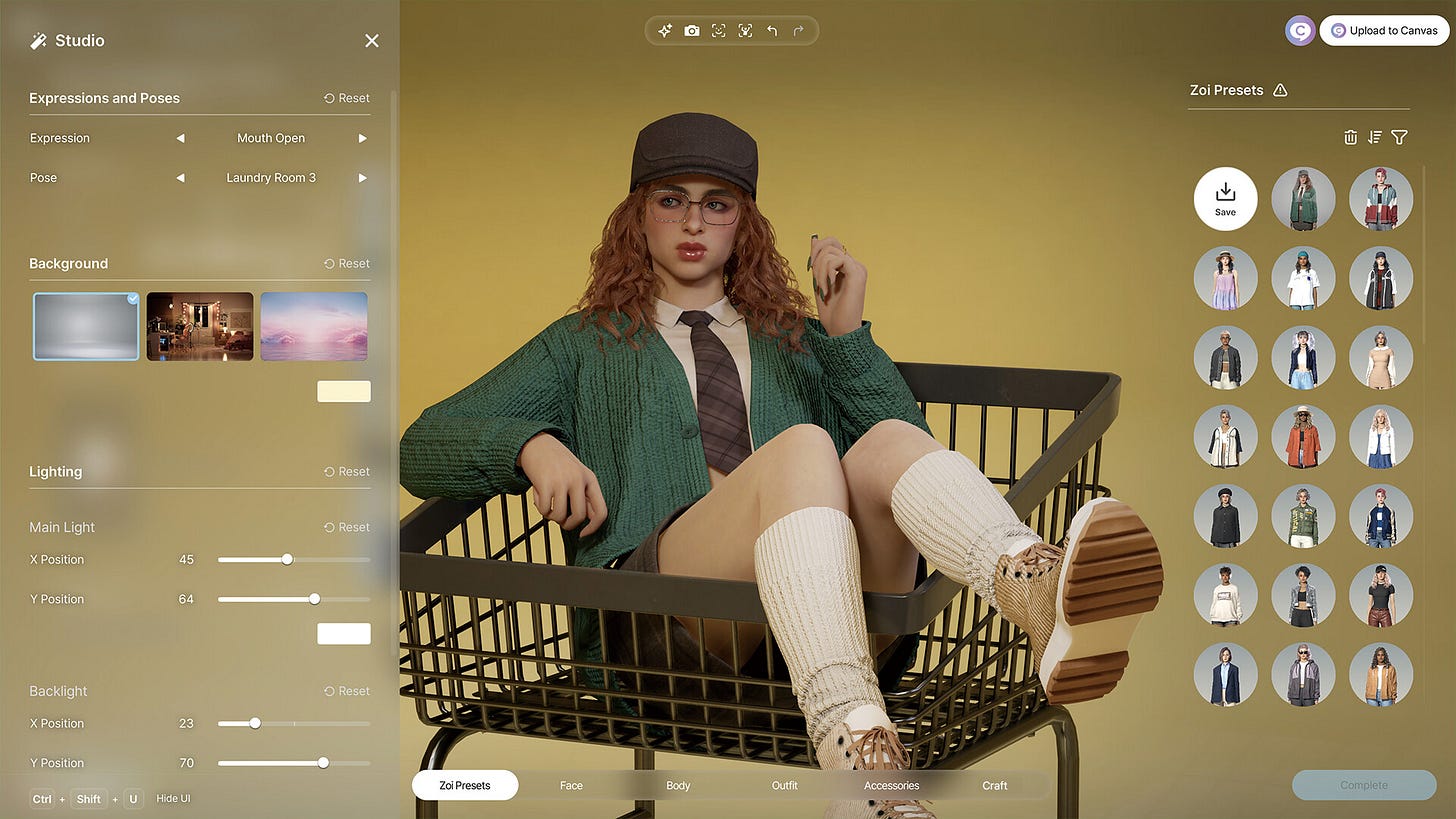Will AI Fashion Have Its Debutante Moment Through Video Games?
A look at how AI could bolster fashion in games, not threaten it.
Good morning! Today we’re publishing our first guest post – an article on the potential of video games to be a launchpad for AI fashion by James Davis of
. James was formerly the Gaming Editor at High Snobiety and has a blog dedicated to bringing a style perspective to the world of gaming. If you aren’t subscribed already I’d highly suggest you check it out. And in case it’s my name you’re reading for the first time This Outfit Does Not Exist is a newsletter and Instagram page dedicated to exploring our bleeding edge future — where fashion, technology and culture collide.Now on to the good stuff.
AI Fashion hasn’t quite become the industry disruptor we first thought it might have been - at least for the designer. While there’s been a small cohort of tastemakers combining AI and physical craftsmanship to make truly unique designs (see Robbie Barrat for Acne Studios) - any genuine attempts at using AI as a complementary tool in the design process has been drowned out by slop. We’ve seen a barrage of soulless “singulari-tee’s” on Etsy where generative design tools are being used—but not necessarily loved. For every progressive move in AI-generated fashion by independent designers, there’s a big corporate like PUMA replacing these creative upstarts with a cheeky text-to-sneaker prompt. The public backlash to such synthetic products reminds us that creativity isn’t a prompt—it’s a process.
When AI is pitched as a backstage assistant—helping with inspiration, search, or styling (as seen in tools like OneOff or Gen Z’s rampant use of ChatGPT as a personal stylist), we still see the same tension. The idea of AI replacing a flesh-and-blood creative still sends shudders through the fashion establishment - just ask H&M. And rightfully so. But is there a chance for it to thrive elsewhere? In worlds which are already uncanny?
Video Games & The Customisation Craze
Step into a video game, and suddenly that AI-generated pink feather suit becomes the talk of the town - for the right reasons. For decades, games like The Sims, Neopets, and Animal Crossing have been bubbling playgrounds of aesthetic experimentation with deep customisation tools at player disposal. Dressing your avatar in many games is considered to hold equal importance to the gameplay itself. Outfits are even tied to game progression or exploration, like in Ghost of Tsushima where you need armour sets like the Samurai Clan Armor to acquire new combat features. Players feel rewarded when earning such attire. In The Sims, entire subcultures of Simstagrammers treat every outfit change like a seasonal lookbook drop.
Customisation isn’t just a feature in these games—it’s a language. It’s where players experiment with identity, find their taste, or cosplay an aesthetic they can’t access (or confidently wear or afford!) in real life. Entire game formats have spawned from customisation obsession, the most recent success story of this being Roblox’s Dress To Impress - a destination for bit-checking. Games like Destiny 2 even have their own physical fan zines that spawn from grassroots customisation communities within the game.
The culture of customisation in video games runs deep - but for the less creatively inclining players, there’s a gap. The skill curve is one thing, but equally, just because everyone can express themselves through customisation, doesn’t mean everyone will go deep.
The Gap Between Customisation & Creativity
For all their customisation options, most games still fall short of true creativity. The tools are there, but the execution is complex.
Take Roblox - Gen Alpha’s biggest playground. It’s hailed as a DIY design hub, but building something truly fresh on the platform often demands 2D/3D software fluency. And while the Marketplace boasts millions of experimental items, the most favourited ones? Basic black hoodies. Chuck Taylor knock offs. Copy-paste fits.
This makes sense when one considers that most people on the platform are young teens, trying to find their voice stylistically. Perhaps they’re looking to fit in rather than stand out. Perhaps not everyone is looking to become the next style icon. Instead, they’re just looking at Roblox as a platform to hang out and try new things. The most popular game on Roblox right now is Grow Your Garden - a simple game about gathering seeds and growing vegetables, with very little do to with fashion. Roblox is effectively Gen Alpha’s version of the shopping mall - some are looking to actually shop and style themselves, others are just there to hang out in the food courts, go to the movies or play at the arcade.
But even when we look at style focused games on Roblox, like Dress to Impress, where players compete to fit a theme, the results tend to veer formulaic. “Goth” becomes black lipstick and mesh. “Y2K” turns into butterfly clips and baby tees. It’s not subversion—it’s a moodboard regurgitated. This isn’t to discredit player imagination, but to point out a key bottleneck: the difference between picking from presets and creating something new yourself.
Most customization is remix, not invention. And in games, just like in fashion, remix culture can only go so far before it starts to feel…samey.
When Generative AI Becomes Your In-Game Atelier
This is where generative AI re-enters the chat — not as a threat to designers, but as a democratizing tool.
New games like InZoi (a hyperrealistic competitor to The Sims) have begun to show what happens when players are given intuitive AI tools. The game’s Creator Studio lets users type prompts to generate textures for clothes or accessories. Want a wallpaper covered in rubber ducks wearing cowboy hats? Done. Want to 3D print a neon halo for your avatar’s head based on a JPEG? Go for it. Don’t know how to animate a pose? Feed it a photo and let the AI do the work.
In InZoi, the player becomes the designer without needing to master the software. AI doesn’t replace imagination—it frees it from technical bottlenecks. It helps players jump from vibe to vision faster.
Meanwhile, Roblox is gearing up to introduce its Cube AI model, a game-changer in UGC creation. With Cube, players will be able to generate entire interactive 3D objects—clothing, props, environments—via natural language. It’s like speaking a look into existence. The platform already boasts 97.8 million daily active users, and Cube promises to turn more of them into creators, not just consumers.
This could be the true promise for AI fashion—not as a high-fashion gimmick or corporate stunt, but as a utility in digital worlds where creativity is currency.
Finally Finding The Runway
AI fashion’s real runway might not be Paris or Milan, but in the esoteric minigames of Roblox, the build menus of The Sims, and the chaotic closets of InZoi. Here, AI isn’t being judged against the refined vision and craft of Raf Simons or Rei Kawakubo. It’s being used by kids trying to design an outfit that matches their latest TikTok dance routine or their group chat’s personal joke. Generative AI in video games is a genuine solution for kids to keep up with the calamity of social media “cores” - responding at breakneck speed with the power of a prompt.
In the real world, AI-generated fashion continues to reckon with the evolving perceptions of human creativity. But in video games — where identity is pixelated, aesthetics are fluid, and everything is already non-human — it makes sense.
So maybe AI fashion won’t disrupt the fashion week calendar in ways we might have first thought. But it might just redefine what it means to be a kid with no formal design skills in a video game with a dream to design something straight from their imagination.
This could be AI’s debutante moment. Not in the studio, but in the avatar editor.
– James Davis,










